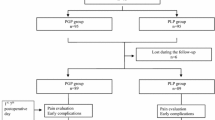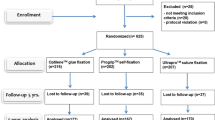Abstract
Background
The use of prosthetic materials has become the standard of care in the management of incisional hernias because of its association with a low rate of recurrence. In this paper, the results of the treatment of incisional hernias is reported.
Methods
Over a 15-year period, 354 open abdominal wall incisional hernia repairs were performed using the Rives–Stoppa, onlay and inlay techniques. The prosthetic materials used were polypropylene and Mersilene mesh. Using a questionnaire, the individual characteristics, type of operation (technique), type of prosthesis, complications and surgical outcome were recorded and analysed by SPSS software.
Results
A total of 354 patients underwent prosthetic incisional hernioplasty, comprising 265 women and 89 men, with a mean age of 52.1 years, using three techniques that included Rives–Stoppa (312), onlay (33) and underlay (9). The majority of complications included seroma (10), infection (8), intestinal fistula (2), mesh removal (2) and respiratory complication (4). Eighty percent of the patients used abdominal belts after the surgical procedure. Recurrent hernias were observed in four patients with a mean of 98 months follow up. All patients received pre-operative intravenous antibiotics and were discharged with oral antibiotics.
Conclusion
In this series, the prosthetic incisional hernioplasty approaches, especially the Rives–Stoppa method, yielded excellent long-term results, with minimal morbidity in patients and large primary or recurrent incisional repair.

Similar content being viewed by others
References
Espinosa-de-Los-Monteros A, de la Torre JI, Ahumada LA, Person DW, Rosenberg LZ, Vásconez LO (2006) Reconstruction of the abdominal wall for incisional hernia repair. Am J Surg 191:173–177
Harrell AG, Novitsky YW, Kercher KW, Heniford BT (2007) Ventral herniations in adults. In: Yeo CJ (ed) Shackelford’s surgery of the alimentary tract, 6th edn. WB Saunders, Philadelphia, pp 678–686
Malangoni MA, Rosen MJ (2008) Hernias. In: Townsend CM, Beauchamp RD, Evers BM, Mattox KL (eds) Sabiston textbook of surgery, 18th edn. WB Saunders, Philadelphia, pp 1171–1175
Gray SH, Vick CC, Graham LA, Finan KR, Neumayer LA, Hawn MT (2008) Variation in mesh placement for ventral hernia repair: an opportunity for process improvement? Am J Surg 196:201–206
Harris JP, Adrales GL, Chu U, Schwartz RW (2003) Abdominal ventral incisional herniorrhaphy: a brief review. Curr Surg 60(3):282–286
Manigrasso A, Candioli S, Arcieri S, Palazzini G, Filippini A (2009) Incisional hernia prosthetic surgery: a prospective study comparing laparoscopic and open techniques. G Chir 30(5):201–214
Kingsnorth A, Banerjea A, Bhargava A (2009) Incisional hernia repair—laparoscopic or open surgery? Ann R Coll Surg Engl 91(8):631–636
Yaghoobi Notash A, Yaghoobi Notash A Jr, Seied Farshi J, Ahmadi Amoli H, Salimi J, Mamarabadi M (2007) Outcomes of the Rives–Stoppa technique in incisional hernia repair: ten years of experience. Hernia 11(1):25–29
Venclauskas L, Silanskaite J, Kanisauskaite J, Kiudelis M (2007) Long-term results of incisional hernia treatment. Medicine (Kaunas) 43(11):855–860
Iqbal CW, Pham TH, Joseph A, Mai J, Thompson GB, Sarr MG (2007) Long-term outcome of 254 complex incisional hernia repairs using the modified Rives–Stoppa technique. World J Surg 31:2398–2404
Moore M, Bax T, MacFarlane M, McNevin MS (2008) Outcomes of the fascial component separation technique with synthetic mesh reinforcement for repair of complex ventral incisional hernias in the morbidly obese. Am J Surg 195:575–579
Bauer JJ, Harris MT, Gorfine SR, Kreel I (2002) Rives–Stoppa procedure for repair of large incisional hernias: experience with 57 patients. Hernia 6(3):120–123
Donati M, Gandolfo L, Privitera A, Brancato G, Donati A (2008) Day hospital for incisional hernia repair: selection criteria. Acta Chir Belg 108(2):198–202
Kurzer M, Kark A, Selouk S, Belsham P (2008) Open mesh repair of incisional hernia using a sublay technique: long-term follow-up. World J Surg 32:31–36
den Hartog D, Dur AH, Tuinebreijer WE, Kreis RW (2008) Open surgical procedures for incisional hernias. Cochrane Database Syst Rev (3):CD006438
Stoppa R, Louis D, VerHaeghe P, Henry X, Plachot JP (1987) Current surgical treatment of post-operative eventrations. Int Surg 72:42–44
Wantz GE (1991) Incisional hernioplasty with Mersilene. Surg Gynecol Obstet 172:129–137
Amid PK, Shulman AG, Lichtenstein IL (1994) A simple stapling technique for prosthetic repair of massive incisional hernias. Am Surg 60:934–937
Liakakos T, Karanikas I, Panagiotidis H, Dendrinos S (1994) Use of Marlex mesh in the repair of recurrent incisional hernia. Br J Surg 81:248–249
Mclanahan D, King LT, Weems C, Novotney M, Gibson K (1997) Retrorectus prosthetic mesh repair of midline abdominal hernia. Am J Surg 173:445–449
Leber GE, Garb JL, Alexander AI, Reed WP (1998) Long-term complications associated with prosthetic repair of incisional hernias. Arch Surg 133:378–382
Luijendijk RW, Hop WC, van den Tol MP, de Lange DC, Braaksma MM, IJzermans JN, Boelhouwer RU, de Vries BC, Salu MK, Wereldsma JC, Bruijninckx CM, Jeekel J (2000) A comparison of suture repair with mesh repair for incisional hernia. New Engl J Med 343:392–398
Flum DR, Horvath K, Koepsell T (2003) Have outcomes of incisional hernia repair improved with time? A population-based analysis. Ann Surg 237:129–135
Heartsill L, Richards ML, Arfai N, Lee A, Bingener-Casey J, Schwesinger WH, Sirinek KR (2005) Open Rives–Stoppa ventral hernia repair made simple and successful but not for everyone. Hernia 9(2):162–166
Bingener J, Buck L, Richards M, Michalek J, Schwesinger W, Sirinek K (2007) Long-term outcomes in laparoscopic vs open ventral hernia repair. Arch Surg 142(6):562–567
Iannitti DA, Hope WW, Norton HJ, Lincourt AE, Millikan K, Fenoglio ME, Moskowitz M (2008) Technique and outcomes of abdominal incisional hernia repair using a synthetic composite mesh: a report of 455 cases. J Am Coll Surg 206:83–88
Hut’an M, Hut’an M (2008) Experience with ventral hernioplasties according to Chevrel with “on-lay” prolene mesh. Rozhl Chir 87(4):190–194
Rosen MJ (2009) Polyester-based mesh for ventral hernia repair: is it safe? Am J Surg 197(3):353–359
Author information
Authors and Affiliations
Corresponding author
Rights and permissions
About this article
Cite this article
Abdollahi, A., Maddah, G.H., Mehrabi, B.M. et al. Prosthetic incisional hernioplasty: clinical experience with 354 cases. Hernia 14, 569–573 (2010). https://doi.org/10.1007/s10029-010-0685-9
Received:
Accepted:
Published:
Issue Date:
DOI: https://doi.org/10.1007/s10029-010-0685-9




